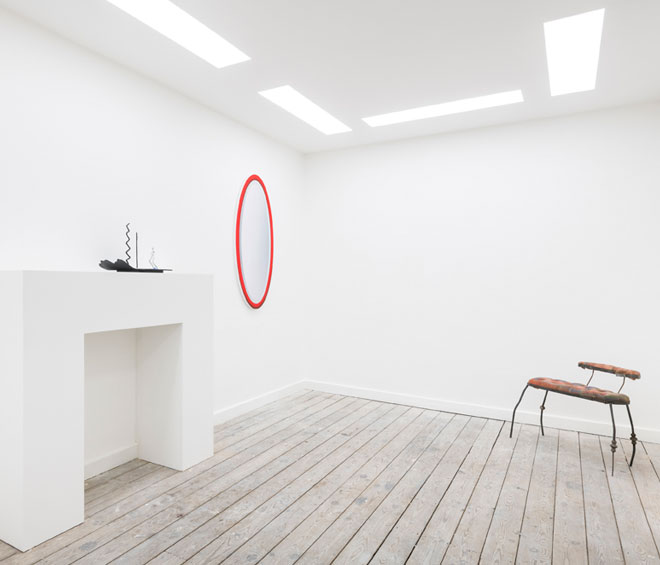
by IZABELLA SCOTT
I first saw Clementine Keith-Roach’s nipple urns in Athens, where the artist and set-designer and her partner Christopher Page were living for a year. She was pregnant, and her anthropomorphised classical urns, already feminised vessels, seemed to take on the changes to her body. Roach’s practice has often been entwined with the domestic – situated in interior spaces, in friendships and family relationships, taking the forms of telephones, pots and chairs. She creates atmospheres of opulence that are also tricks of the eye: trompe l’oeil leopard skin, plastercast plug sockets, marble-coated water coolers and chess pieces cast from coins.
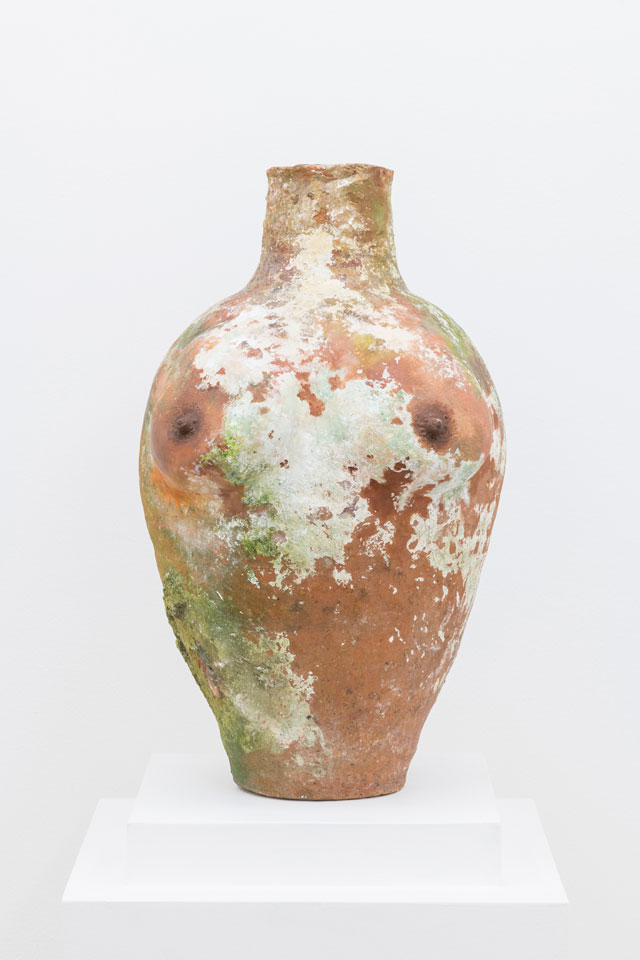
Clementine Keith-Roach. Lac, 2018. Ceramic, plaster, paint, 52 x 34 x 32 cm.
I meet Keith-Roach (b1984) on Princes Place in Mayfair, to visit Interiority, an exhibition at Hunter/Whitfield akin to a set, which includes an aluminium grandfather clock by Simon Mathers, a trompe l’oeil painted mirror by Christopher Page and a spindly chaise longue by Ben Burgis and Ksenia Pedan. Hunter/Whitfield has recently relocated to this narrow Victorian townhouse, and Interiority reflects an elegant “pad” of sorts, but also a community: a set of artists and makers who are Keith-Roach’s friends, colleagues and confidants, and with whom she has been in conversation for a decade. Two of her breast urns are on display here – Lac (2018) and Kore (2018) – as are another pair across London, at Grace Belgravia, a luxury club including a spa and medical centre for women, which occasionally doubles as an exhibition space.
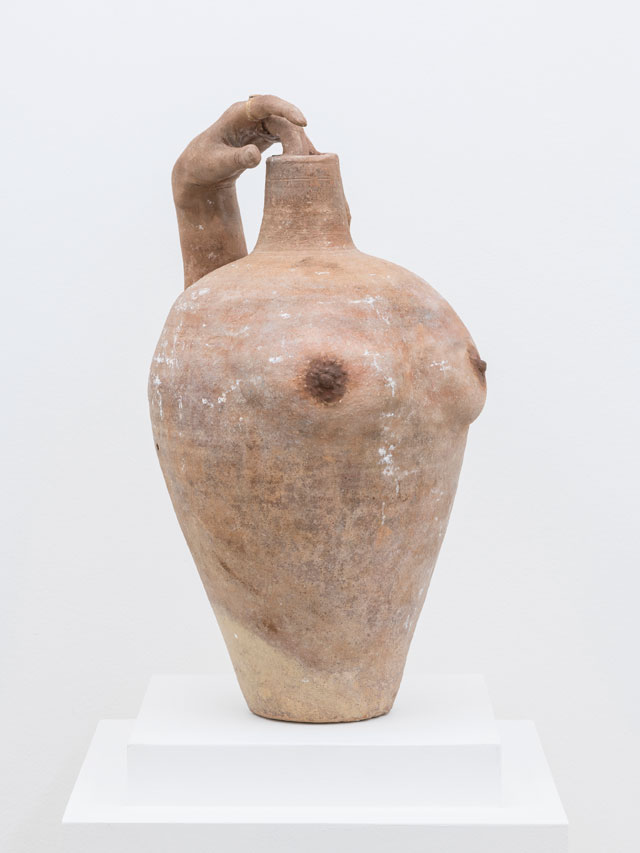
Clementine Keith-Roach. Kore, 2018. Ceramic, plaster, paint, Roman ring, 52 x 30 x 27 cm.
It is snowing when we meet and the city is white. Keith-Roach is wearing a large dappled-fur hat and an oatmeal cashmere coat, beneath which I glimpse a Mattise-patterned knit – the unmistakable leaves of the cheese-plant. When Hunter/Whitfield closes, we escape the cold in a warm, dimly lit cafe in the basement of Waterstones bookshop. Over a cup of chocolate-flavoured rooibos, we talk about fertility cults, wireless breastpumps and bodybuilding with breastmilk.
Izabella Scott: The objects in Interiority are arranged like furniture in a drawing room: one painting poses as a mirror, another sculpture is a dwarfed chaise longue. One plinth that you constructed for the show clearly echoes a mantelpiece, holding a sculpture that becomes a domestic showpiece. Who do you imagine inhabiting the space? Is it you?
Clementine Keith-Roach: This exhibition, Interiority, does allude to a domestic interior. The artworks in it are arranged like furnishings that make the gallery into a kind of mise-en-scène. As curator of this quasi-domestic space, I am also a “homemaker” and, given that I am also a set designer, you might imagine that this is a set that is a reflection of myself. But, to me, the exhibition does not fully cohere into a set because the objects themselves are so strange and powerful and particular – they are the protagonists and it is them that inhabit the space.
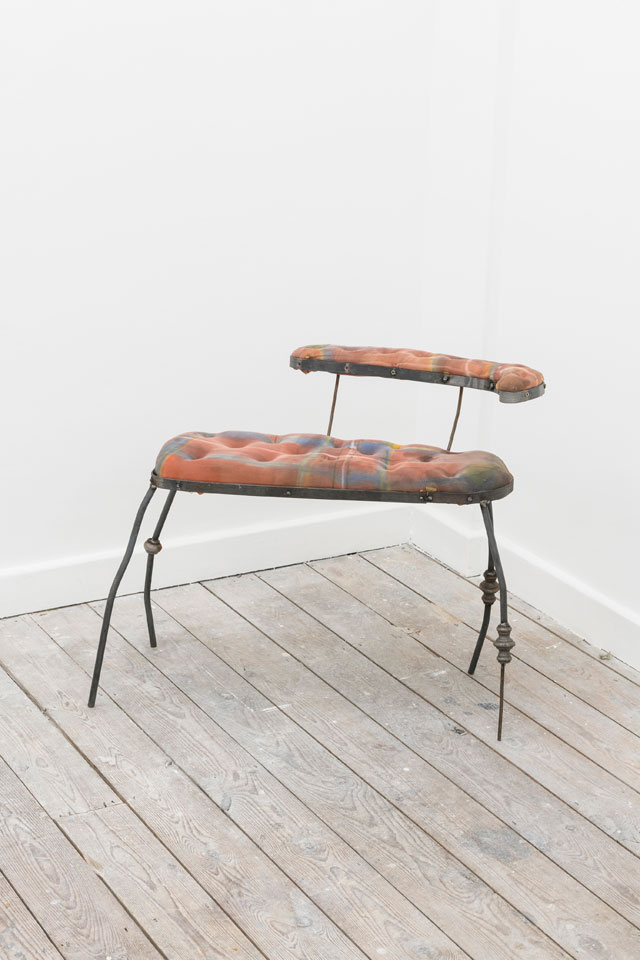
Ben Burgis and Ksenia Pedan. Musk Chaise, 2017. Metal, foam and painted fabric, 74 x 28 x 62 cm.
IS: Did one object come first?
CKR: The constellation of artists came first. I have been following all their work for a long time and the concept behind the show grew out of the links that were already there – that interiority or domesticity plays into all of their work in one way or another. For example, Beatrice Loft Schulz often engages in processes such as beadwork, papier-mache that have historically been aligned with homemaking and thus gendered. Jesse Wine’s sculptures are ceramic, a medium traditionally used to produce homeware, and they often take the form of domestic objects, such as mugs or wine bottles. Meanwhile, Ben Burgis and Ksenia Pedan create entire interior installations, seamless environments comprised of objects that are distressed and mutated. Their work in Interiority, Musk Chaise (2017), was plucked from one such installation – it is a chaise longue that is creepily small, a strange variation of scale, and it feels as though it might start crawling along the floor, scuttling like a spider. Made of welded metal and tartan, the chaise has allusions of grandeur in the ornate detail on its otherwise bare legs, in its button upholstery and painted tartan checks. But its dishevelled form also feels humiliated, somehow. It conjures a complex set of emotions.
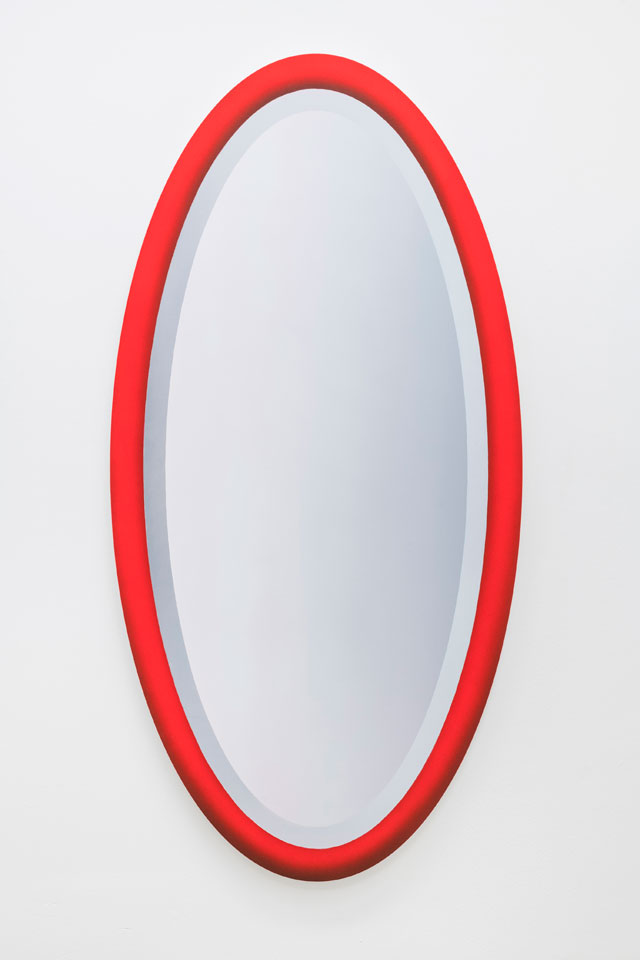
Christopher Page. Speculum, 2018. Oil and acrylic on panel, 120 x 60 cm.
IS: You describe the chair as a character, a subject. Is each object in the show personified like this?
CKR: Some of the works are explicitly personified, even bodily. Christopher Page’s painting, Speculum (2018), a trompe l’oeil mirror with a gradated grey surface and a bright red frame, meets you as both a blank mirror and an orifice; Simon Mathers’s grandfather clock, Only Forward (2018) looms like a body and is crowned by a grimacing pink gargoyle; and my own works are vases with nipples and limbs.
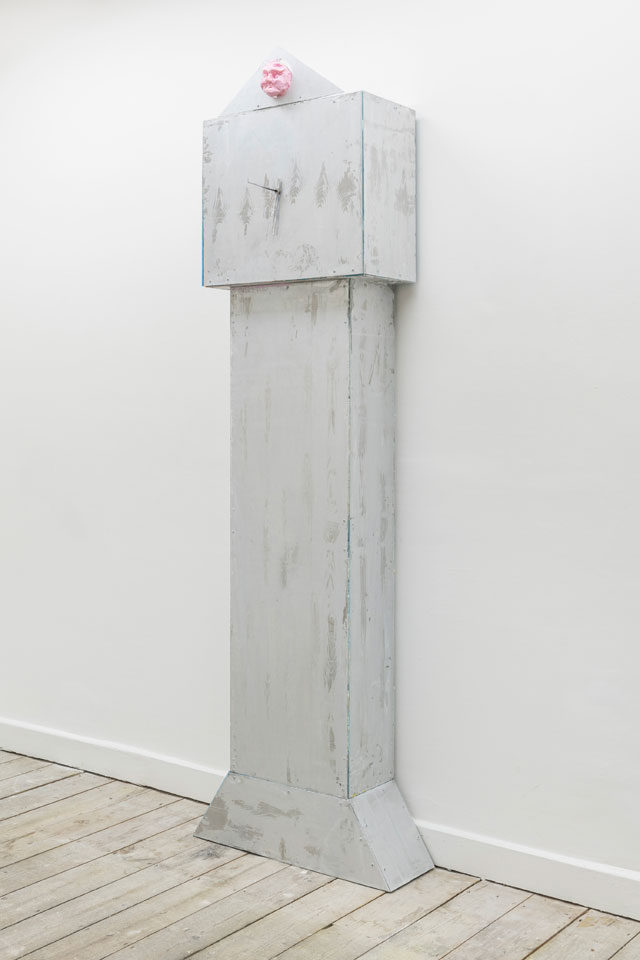
Simon Mathers. Only Forward, 2018. Aluminium and epoxy resin, 203 x 62 x 24 cm.
Other works appear like strange domestic objects overflowing with psychic charge. Jack McConville’s paintings share something with Édouard Vuillard in rendering decorative motifs unbound and open to psychological flux. Schulz’s rug, Rain (2018), is also a compact image that she describes as a poem, and Jesse Wine’s ceramic Yawn, yawn, England Prawn (2018) strikes me as a perverse Victorian mantel sculpture.
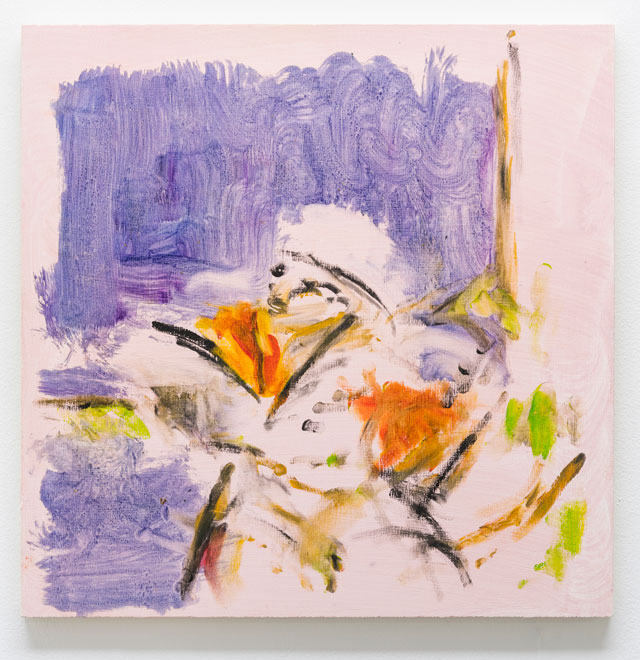
Jack McConville. Veranda at Dusk, 2018. Oil on board, 40 x 40 cm.

Beatrice Loft Schulz. Rain, 2018. Yarn on rug canvas, 92 x 71 cm.
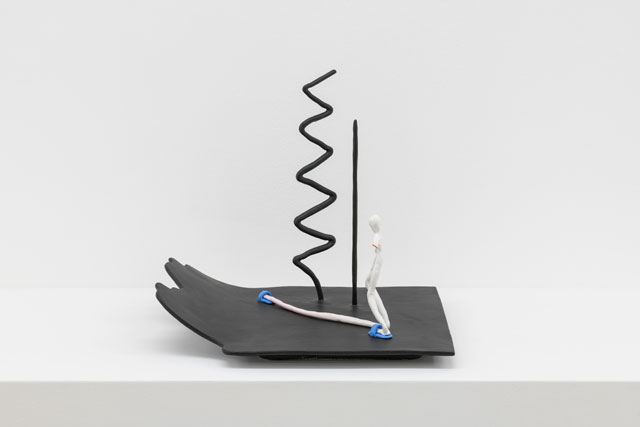
Jesse Wine. Yawn, yawn, England Prawn, 2018. Glazed ceramic, 35.6 x 43.2 x 38.1 cm.
IS: Is there something particularly psychic, or feminised, about the Victorian interior? I think of Charlotte Perkins Gilman’s short story The Yellow Wallpaper (1892), on rest cure, hysteria and the enclosure of women.
CKR: The exhibition is haunted by the Victorian interior, an era that saw the introduction of mass urban housing, and when the psychological entanglements of people and their domestic space started being registered in painting and literature. Ben and Ksenia’s “chaise”, Christopher Page’s oval “mirror” and Simon Mathers’ “grandfather clock”, for example, all stem from typologies of domestic furnishing popular in Victorian England. And yet every work in Interiority disrupts such straightforward recognition. Material, surface, form and approaches to figuration are all sites of excess and hybridisation that make each work point to multiple eras and histories.
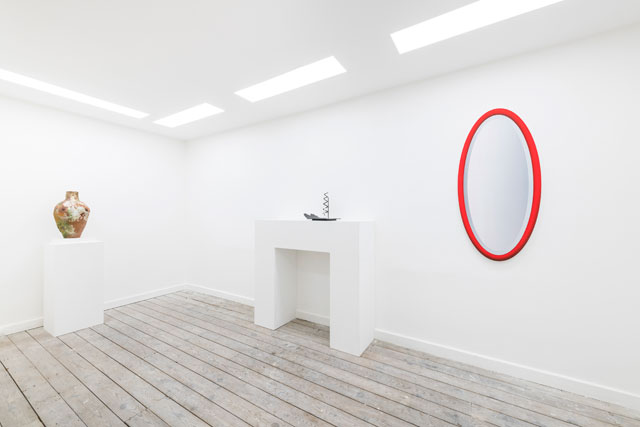
Interiority, 2018. Installation view, Hunter/Whitfield, London.
IS: It makes me think of an old anecdote – Victorians covering up piano legs because they were too rude – which demonstrates a prudish relation to objects, investing them with so much human character that they need to be disciplined. Do you think of furnishings as a conversation with bodies, the human form?
CKR: I think of domestic objects and furniture as physical extensions of our body – they prosthetically extend our body beyond itself. They also have bodily qualities themselves: they have their own grammar and syntax of arms, legs, necks. They are thus intimate things, deeply familiar, we share the world with them. But they are also very alien things, too – they come out of invisible factories, the hands that have produced them are erased from their surfaces, and the materials they are made of are often unnameable. They are hieroglyphs of an economic order that has abstracted itself completely from our bodies.
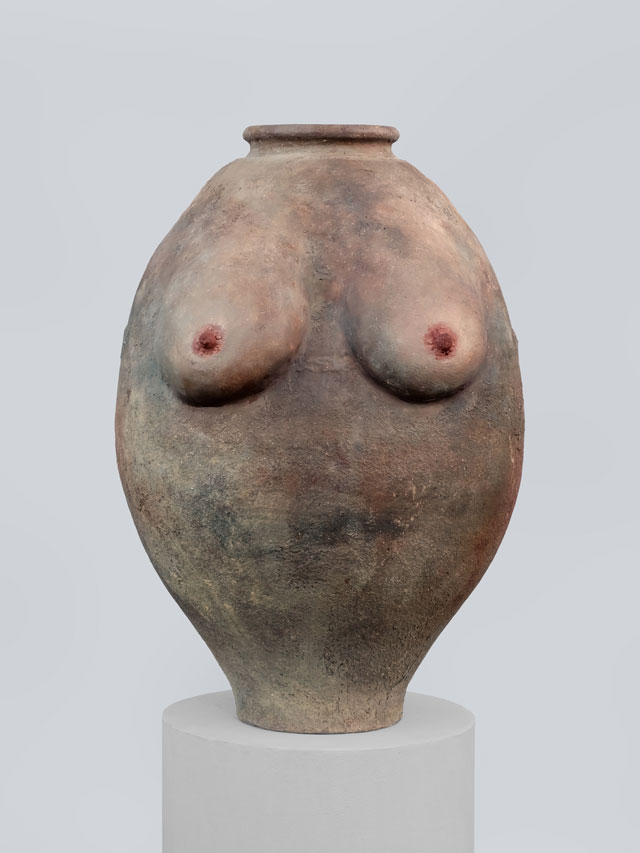
Clementine Keith-Roach. Opis, 2018. Ceramic, plaster, acrylic paint, 55(h) x 33(w), 118 cm circumference.
IS: The past year of experience – which includes living in Athens, having a baby – seem to come together in the nipple urns you have been producing – shown recently at Hunter/Whitfield gallery and Grace Belgravia in London – urns with breasts that are transformed into female bodies. When did they begin?
CKR: My nipple vases are the culmination of all these forces. I spent my time in Athens visiting the museums and archaeological sites. Places such as the Temple of Artemis in Vravrona – devoted to the goddess and protector of fertility and childbirth – and the sanctuary of Delphi – thought of by the Greeks as the navel of the world – were hugely inspirational. I was particularly drawn to the domestic ceramics because they are both modest objects of use, and also have a powerful symbolic dimension. Some of them are anthropomorphised or zoomorphised – they have human and animal features. I came across a most unusual vase named a “Cycladic Nipple Ewer” from circa 3,500BC – the vase has a full body and pinched clay nipples that transform the pot into a female figure. It is believed that this form of vessel was used for libations as a part of a fertility ritual. I was so struck by the obscure typology of vase that I decided to make a series of work based on it. It was during this period that I became pregnant and later began breastfeeding, which made my body into a kind of libation vessel! My early nipple vases were reminiscent of the Cycladic pot, more abstract and stylised, but after experiencing the machinic power of the maternal body I began casting breasts, exposing the anatomical detail of the nipple, areolae and surrounding skin.
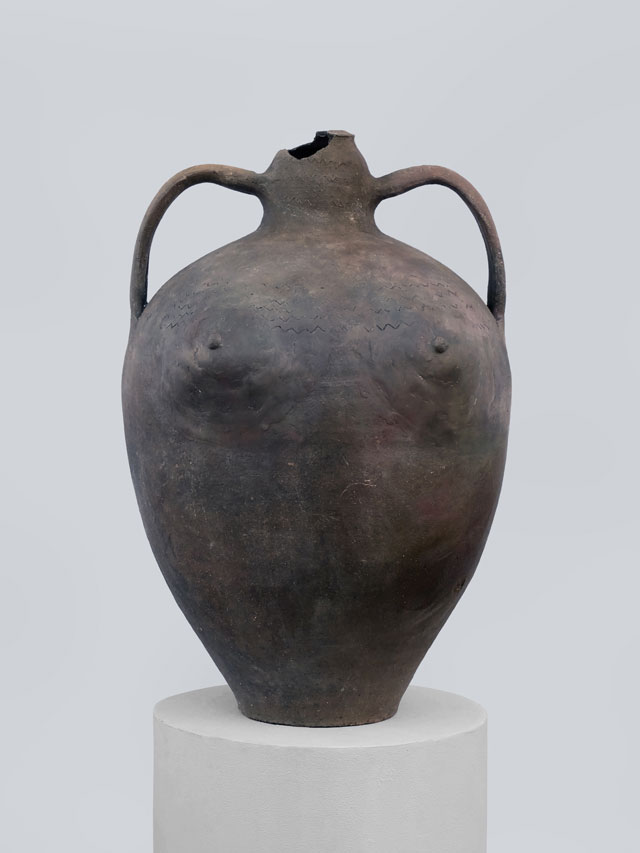
Clementine Keith-Roach. Omphalos, 2018. Ceramic, plaster, acrylic paint, 48(h) x 29(w),100 cm circumference.
IS: The plasticity of clay made it an important material for casting the body, mimicking the human form. I’m thinking of Mississippian effigy pots from 800AD.
CKR: The human body’s relationship to clay goes back into prehistory, but a salient example is the book of Genesis – Adam (or Adamah) is thought to mean red clay. I scour the earth for the right antique terracotta pots, usually Mediterranean storage jars such as amphorae – which have two handles and a narrow neck and are used to store wine – and pithoi, wider-necked pots used for storing olive oil or grain. I look for pots that seem to hold a life force that wants bringing out. I then work into them, sculpting cast plaster breasts on to the surface of the pot, drawing the body out of its form and then blending the patina of the clay into the skin of the breast using illusionistic painting techniques. The breasts I use are casts of the bodies of women who are very close to me – the process is an intimate and tactile exchange. I used my own body while pregnant and have used the breasts of my mother, the very nipples that nurtured me into being.
IS: There is a relationship to breastfeeding, too, in your recent exhibition with the Seeld Library collective at the Museum of Contemporary Art in Los Angeles. I think of Maggie Nelson’s 2015 memoir The Argonauts, which she wrote while pregnant, and later with her breast at the pump. The book is an ambush on the pervading stereotypes around pregnancy, which she describes as “that wild oxymoron, the pregnant woman who thinks”.
CKR: In the run up to the show at MoCA, I was breastfeeding all the time. In the first few months of having a baby, I understood certain structural realities that tie women to the labour of motherhood, to the domestic space, to feeding an infant. My experience of using a breast pump was ambiguous – I thought it would allow me some freedom from the constant task of feeding – but it took me up to an hour to fill a small bottle (which is much less efficient than a baby suckling), and the secret pumping in the loo when I went out in the world felt somehow degrading. I discovered there are many varieties of breast pumps, which have been developed to aid the nursing mother. Some hi-tech, wireless contraptions cost more than $400 (£280) a pump, and can be slotted into the bra, like breast enhancements, so that mothers can secretly pump at work. Is this a form of liberation, or just another example of mothers “doing it all”: overworked, exhausted?
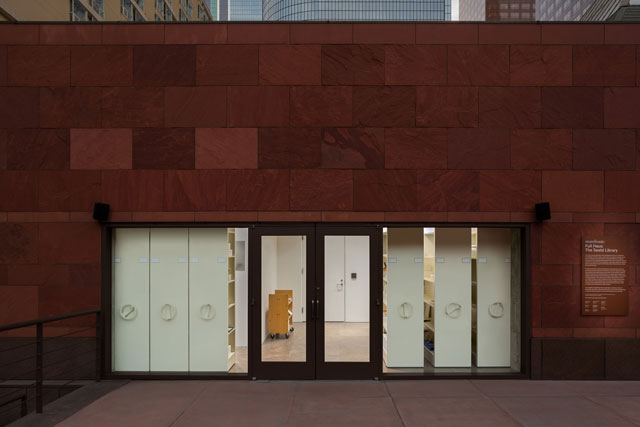
Storefront: Full Haus: The Seeld Library at The Museum of Contemporary Art Los Angeles.
This encounter with breast pumps led me to the work I made for the Seeld Library exhibition, where I focused on the prostheses surrounding breastfeeding. I became fascinated by the history of artificial aids to, and mediators between, the maternal and infant body. I made milky resin casts of the negative spaces from the components of breast pumps and baby bottles – especially those parts that intersect with the body, such as the silicon suction cups in pumps and the teats on bottles – from which strange breast- and mouth-like forms emerged. I displayed these items as if they were fragments from an archaeological dig. Alongside this work I produced a Mnemosyne Atlas – a kind of picture atlas proposed by Aby Warburg – of such prostheses from ancient history to now, for a journal called Effects. This was printed next to an essay by Esther Leslie and Melanie Jackson on milk, its social history and fantasy life.
IS: The exhibit included an advert for the sale of breast milk, which became a sound piece. I find it hard to imagine human breastmilk for sale. Is it regulated?
CKR: My research into breast pumps took me to the website onlythebreast.com – a kind of Gumtree for buying and selling breastmilk. Mothers who have stockpiled frozen breast milk can sell their surplus to women who cannot produce enough milk for their babies for an average of one dollar an ounce. Unsurprisingly, the market for breastmilk – or “liquid gold” as it is referred to – is not only for babies, and there is a whole section called “Men buying breast milk”. There are sub-section consumers here: bodybuilders seeking its high-calorie content, men in recovery seeking its alleged health benefits, as well as requests for regular adult nursing. I was interested in the way women present themselves on the site, advertising the quality of their milk through a detailed description of their dietary habits, exercise routine and peppered with seductive details of a happy lifestyle. For the sound piece, I produced my own advert for breastmilk compiled from various others on the site, with the strange shorthand they use, and had a computer-generated female voice read it out to very eerie effect.
IS: It makes me think of the sheep placenta, used in anti-wrinkle creams; or royal jelly used as a supplement to boost fertility. But the sale of human fluids is rather more complicated. The very reason that blood is donation only, is because of the atrocious micro-economies that often emerge: people selling blood in desperation.
CKR: Breastmilk is a slippery substance – as Esther Leslie and Melanie Jackson make clear in their essay in Effects: it is not a single substance, but a more complex cocktail. Is it a food, a drug or a bodily fluid? Is it a single fluid or many? At present, it is unclassified by the US Food and Drug Administration, which is what allows this kind of unregulated buying and selling to go on. Would we want classification, or would that only certify its commodity status? These difficulties touch on the problematics of bodies and economies that I find fascinating and terrifying – and which drives me forward.
• Clementine Keith-Roach’s work is included in Interiority at Hunter/Whitfield, London, until 15 April 2018; 3 New Sculptures at Menagerie in Twentynine Palms, California, until 31 May 2018; and Full Haus: The Seeld Library at the Museum of Contemporary Art Los Angeles until 8 July 2018.